Pikachu
Pikachu (ピカチュウ, Pikachū?) is one of the creatures in the Pokémon franchise. This character made its first appearance in the video games Pokémon Red and Blue (Green in Japan)., being the 25th Pokémon on the list of Pokémon registered in the national Pokédex. Like all Pokémon, Pikachu fights in pivotal battles in the anime, manga, and video games of the series. Pikachu is the best-known Pokémon in history since it is the companion of the series' protagonist, Ash Ketchum, and the representative mascot of the Pokémon franchise.
Pikachu evolves from Pichu when its friendship level increases, and evolves into Raichu with a thunder stone in the Kanto region, in the Alola region, by exposing Pikachu to a thunder stone, it evolves into Alola Raichu. Within the world of the Pokémon franchise, Pikachu are generally found in houses, forests, grasslands, and occasionally near mountains, islands, and power sources, in most regions of the Pokémon world.
Origin and design
Artist Atsuko Nishida is credited as the primary person behind the design for Pikachu, which was later finalized by artist Ken Sugimori. According to series producer Satoshi Tajiri, the name is derived from a combination of two Japanese onomatopoeia: pika, the sound of an electric spark, and chu, the sound made by mice. However, despite the origins of its name and description, Nishida based the design of first generation Pikachu, especially its cheeks, on those of squirrels.
In the early Pokémon video games, all creatures were portrayed in two-dimensional sprites, but in later versions, their appearance has been projected in 3D graphics. In the anime series, he has facial expressions, body language, and speaks by repeating the syllables of his name using different tones of voice.
Features
General Information
Pikachu is one of the Pokémon that has the appearance of a small mouse, its fur is yellow in color, it has two brown markings that cover its back and a small part of its tail. ears are black, on its cheeks there is a red circle, where the Pokémon expels electrical energy, if it is male its tail is shaped like a lightning bolt and if it is female it is heart-shaped at the end.
In some of the Pokémon video games, according to Pikachu's information provided by the Pokédex, instead of climbing trees looking for berries, it uses small electric shocks at the base of the trees causing the berries to fall to the ground. and help get his food down. When Pikachu is in the presence of a magnetic field, it is unable to discharge electricity, causing flu-like symptoms.
Pikachu evolves into Raichu using a thunder stone. However, it is common for trainers not to develop their Pikachu's abilities before evolving. In the video game Pokémon Yellow, when you use the thunder stone to evolve the Pokémon, it tends to cry and refuses to evolve. From the second generation of the Pokémon games onwards, Pichu, the pre-evolution of Pikachu, appears. Pichu evolves into Pikachu after establishing a close friendship with Pichu's trainer.
Attacks
Pikachu is an Electric-type Pokémon, so its attacks are mostly made up of shocks of static electricity. However, other attacks that the Pokémon employs are of various types, either normal type or fighting to what are apparently punches. This is the list of moves that Pikachu can use in video games, anime and others.
Appearances
In video games
In the video games, Pikachu is a low-level Pokémon usually found in Forest Green, and the Power Plant in the Pokémon Red and Blue games, in the Safari Zone in the Ruby, Sapphire, and Sapphire versions. Emerald and in Diamond, Pearl and Platinum versions at the Trophy Garden.
In Pokémon Yellow, the player has a Pikachu as their starter Pokémon. The game's plot is based on the anime series, so Pikachu refuses to evolve and stay in its Poké Ball, it follows the player around the screen everywhere. Pokémon Let's Go is heavily based on Pokémon Yellow, having Pikachu as its starter Pokémon in one version and using Eevee (the yellow version's rival Pokémon) in the other version.
Pikachu also makes an appearance in the Game Boy series of Pokémon Pinball games and Pokémon mini. In 1998, Pokémon Pikachu, a portable Tamagotchi-like series with the famous mascot Pokémon, was released.
Another Pikachu-focused game is Hey You, Pikachu! for the Nintendo 64 console, where the player interacts with Pikachu through a microphone with which they can issue commands to the Pokémon to play different mini-games and act in various situations. In the Pokémon Channel game, the interaction with Pikachu is similar. Pikachu appears in all levels in the Pokémon Snap game, and is also one of the sixteen playable characters in the Pokémon Mystery Dungeon games. In PokéPark Wii: Pikachu's Adventure, Pikachu is introduced as the main protagonist.
Pikachu also appears as a playable character in the games Super Smash Bros., Super Smash Bros. Melee, Super Smash Bros. Brawl, Super Smash Bros. Wii U / 3DS, and Super Smash Bros. Ultimate. characterized by being a very agile character in his movements. Pikachu's attacks used in these games are Quick Attack, Skull Bash, Thunder Jolt, and Thunder (thunder). Since Super Smash Bros. Brawl, Volt Tackle is Pikachu's finishing move. Pikachu appears as a playable fighter in Pokkén Tournament and also has the amiibo figure of he.
In Detective Pikachu, players work with a Pikachu with the ability to talk to humans to solve mysteries.
In the video game Pokémon Unite, Pikachu is one of the Pokémon available for play. However, it does not evolve.
In the anime
The anime series follows the adventures of Ash Ketchum and his Pikachu, who travel through the various regions of the Pokémon universe in the company of their friends Misty, Brock, Richie, May, Tracey, Dawn, Max (younger brother of May), Todd, Iris, Cilan, Serena, Bonnie, Clemont, Alexa, Lyra, Khoury, and N.
Over the course of the series, many other Pikachu have appeared, either wild or captured by trainers, some of whom have interacted with Ash, Pikachu, and their friends such as Sparky, Richie's Pikachu, and his Charmeleon. Like most other Pokémon, Pikachu communicates only by saying the syllables of its own name, just like most other Pokémon, some don't.
In the first episode, Ash Ketchum receives a Pikachu from Professor Oak as his starter Pokémon. At first, Pikachu largely ignores Ash's commands, refusing to enter Ash's Poké Ball and frequently shocking him. Ash put himself in danger for defending Pikachu from a wild herd of spearow, taking the Pokémon to a Pokémon Center (using Misty's bike). Through these displays of respect and unconditional commitment to his Pokémon, Pikachu began to appreciate Ash and their friendship was formed. Shortly after in the Pokémon Center, due to the great power of Pikachu surpassing the power of its evolution, Team Rocket constantly tries to capture the Pokémon for Giovanni, head of the organization.
Over the course of the series and just like the Pokémon in the video games, Pikachu has gone through various situations such as learning new moves such as Iron Tail and Volt Tackle and even in one episode, despite the fact that its trainer asked the Pokémon to evolve because it was defeated in battle by a Raichu; Pikachu refused and decided to face Raichu again without the need to evolve with the thunder stone. Various events that occurred in the series have made Pikachu part of the cast of anime protagonists along with Ash Ketchum. Likewise, Pikachu in the company of other Pokémon, is the protagonist of several shorts and OVAs where he participates in various adventures where the human characters of the series are not involved.
Voice and dubbing
Pikachu is voiced by seiyū Ikue Ōtani, who also voices other Pokémon in all versions of the anime. Unlike other characters and Pokémon that have been voiced by voice actors in In the various languages the series has been translated into, Pikachu's voice has not been replaced by any other voice actor in all episodes, movies, and specials that make up the Pokémon anime. Between January and May 2006, Ōtani stopped interpreting Pikachu for reasons of pregnancy, however, the production process of the series did not stop as there were already voice recordings of the seiyū interpreting the Pokémon. These recordings were used in the episodes that were being produced during Ōtani's absence.
At the movies
Pikachu is played by Ryan Reynolds in the 2019 film Pokémon: Detective Pikachu, based on the game of the same name.
Other appearances
Pikachu is one of the Pokémon with the most appearances in most of the Pokémon manga. In Pocket Monsters Special, both Red and Yellow train and strengthen their Pikachu. Red's Pikachu was originally captured, but after Red goes missing for two years, Team Yellow and Red's Pikachu are on the hunt for him. Pikachu has also appeared in the Magical Pokémon Journey, Pokémon Getto Da Ze! and in the anime adaptations; Electric Tale of Pikachu and Ash & Pikachu.
Pikachu has also appeared in the collectible card game, Pokémon Trading Card Game since its release in October 1996. The character has been seen in many of the games released in North America, and even more so when there was a promotion for limited edition cards.
Pikachu has been used in advertisements for fast food outlets such as McDonald's and Burger King.
Impact on popular culture
Background
Pikachu first appeared in 1996, among the first 151 pocket monsters in the first Pokémon video games, produced by Game Freak for the Game Boy console. Each of the first 151 Pokémon were treated equally by the game's creators, and it was left to fans to decide which one would become the official mascot of the franchise. Fans chose Pikachu because of his appearance in the anime alongside series protagonist Ash Ketchum.
Today, Pikachu is considered Japan's answer to Mickey Mouse. Pikachu can be obtained in every Pokémon video game to date, with a prominent role in Pokémon Yellow, being one of the protagonists of anime and manga series, including Pocket Monsters Special and Magical Pokémon Journey, where the main characters capture a Pikachu.
Hospitality
Pikachu, being the most famous of the Pokémon, has made its mark on popular culture. Pikachu has appeared in a Got Milk?, on April 25, 2000. In 2001, a Pikachu balloon was seen at the Macy's Thanksgiving Day Parade. Its appearance led to its being included as a question. for radio listeners on the Morning Rush show on May 22, 2006. The original balloon was removed after the tenth anniversary of Pokémon "Decade Party" in New York City's Bryant Park in 2006, and a new balloon of Pikachu chasing a Poké Ball debuted in the parade instead. The balloon was chosen in an online poll conducted by IVillage, winning as the second best balloon in the 2007 parade. An image of Pikachu has also been featured on an ANA Boeing 747-400 (JA8962), landing at London's Heathrow Airport. -2021 a woman appeared with an inflatable Pikachu costume, and it became popular as a symbol of the demonstrations known as "Dance Pikachu".
In 1999, Pikachu was ranked second in Time Asia's Top 10 Characters of 1999 behind Ricky Martin. In 2000, in a 2000 Animax poll of favorite anime characters, Pikachu ranked 8th. In 2002, Pikachu was ranked fifteenth in TV Guide's Top 50 Cartoon Characters of All Time. On the Comedy Central show Drawn Together, a character named Ling-Ling is a direct parody of Pikachu. In 2002, Pikachu appeared on The Simpsons in the episode Bart vs. Lisa vs. the Third Grade.
Pikachurina
A group of researchers from Osaka University have discovered a protein that transmits visual information to the brain more quickly. The name Pikachurina (Pikachurin in English) was due to the agility of the Pokémon Pikachu.
Contenido relacionado
Guess Who's Coming to Dinner
Hogwarts School of Witchcraft and Wizardry
Gene Hackmann






